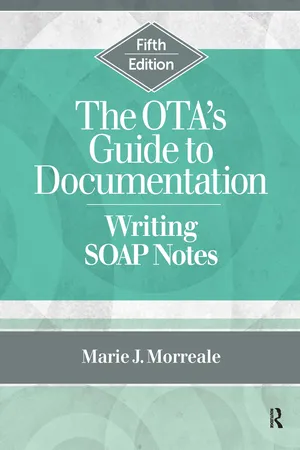
- 352 pages
- English
- ePUB (mobile friendly)
- Available on iOS & Android
About this book
The bestselling, newly updated occupational therapy assistant (OTA) textbook, The OTA's Guide to Documentation: Writing SOAP Notes, Fifth Edition explains the critical skill of documentation while offering multiple opportunities for OTA students to practice documentation through learning activities, worksheets, and bonus videos.
The Fifth Edition contains step-by-step instruction on occupational therapy documentation and the legal, ethical, and professional documentation standards required for clinical practice and reimbursement of services. Students and professors alike can expect the same easy-to-read format from previous editions to aid OTAs in learning the purpose and standards of documentation throughout all stages of the occupational therapy process and different areas of clinical practice.
Essentials of documentation, reimbursement, and best practice are reflected in the many examples presented throughout the text. Worksheets and learning activities provide the reader with multiple opportunities to practice observation skills and clinical reasoning, learn documentation methods, create occupation-based goals, and develop a repertoire of professional language.
Templates are provided to assist beginning OTA students in formatting occupation-based SOAP notes, and the task of documentation is broken down into smaller units to make learning easier. Other formats and methods of recording client care are also explained, such as the use of electronic health records and narrative notes. This text also presents an overview of the initial evaluation process delineating the roles of the OT and OTA and guidelines for implementing appropriate interventions.
New in the Fifth Edition:
- Incorporation of the Occupational Therapy Practice Framework: Domain and Process, Fourth Edition and other updated American Occupational Therapy Association documents
- Updated information to meet Medicare Part B and other third-party payer requirements
- Revised clinical terminology on par with current trends
- Added examples from emerging practice areas
- Expanded tables along with new worksheets and learning activities
Included with the text are online supplemental materials for faculty use in the classroom, this includes: access to supplemental website worksheets, learning activities, and scenario-based videos to practice the documentation process.
Frequently asked questions
- Essential is ideal for learners and professionals who enjoy exploring a wide range of subjects. Access the Essential Library with 800,000+ trusted titles and best-sellers across business, personal growth, and the humanities. Includes unlimited reading time and Standard Read Aloud voice.
- Complete: Perfect for advanced learners and researchers needing full, unrestricted access. Unlock 1.4M+ books across hundreds of subjects, including academic and specialized titles. The Complete Plan also includes advanced features like Premium Read Aloud and Research Assistant.
Please note we cannot support devices running on iOS 13 and Android 7 or earlier. Learn more about using the app.
Information
Table of contents
- Cover
- Half Title
- Title Page
- Copyright Page
- Dedication
- Table of Contents
- Acknowledgments
- About the Author
- Chapter 1 Documenting the Occupational Therapy Process
- Chapter 2 The Health Record
- Chapter 3 Billing and Reimbursement
- Chapter 4 Using Professional Terminology
- Chapter 5 Avoiding Common Documentation Mistakes
- Chapter 6 Writing the “S”—Subjective
- Chapter 7 Writing the “O”—Objective
- Chapter 8 Tips for Writing a Better “O”
- Chapter 9 Writing the “A”—Assessment
- Chapter 10 Writing the “P”—Plan
- Chapter 11 Documenting Special Situations
- Chapter 12 Improving Observation Skills and Refining Your Note
- Chapter 13 Making Good Notes Even Better
- Chapter 14 Evaluation and Intervention Planning
- Chapter 15 Goals and Interventions
- Chapter 16 Documenting Different Stages of Intervention
- Chapter 17 Documentation in Different Practice Settings
- Chapter 18 Examples of Different Kinds of Notes
- Appendix: Suggestions for Completing the Worksheets
- Index